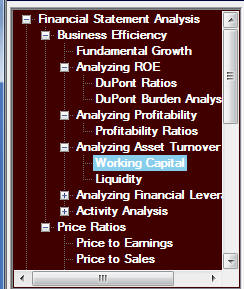3.7 Working Capital Ratio

Working Capital is defined as Current Assets minus Current
Liabilities net of financing and tax related activities.
This leads to eliminating items such as short term debt
and the current portion of long term debt as well as deferred
tax assets/liabilities.
The problem group is cash and marketable securities.
The last group is usually split between the financing and
investment decisions, but predominately is influenced by the
financing decision.
As a result, the usual simplifying assumption is to
eliminate cash and marketable securities from working capital.
With these eliminations it largely consists of:
Accounts Receivable, Inventory and Accounts Payable.
These major components lead to the three major turnover
ratios. The
numerator of these turnover ratios is usually defined relative
to their closest driver.
For example, Accounts Receivable is driven by Sales on
Account and therefore Net Credit Sales is used in the numerator
if available otherwise Sales.
However, under historical cost accounting Inventory as
measured on the balance sheet is more closely aligned with the
Cost of Goods Sold (COGS) for an external analyst.
Finally, Accounts Payable is driven by Purchases and so
either Purchases if available or COGS is used in the numerator
for this ratio.
Formally, we can define them as follows:
Accounts receivable turnover = Sales/Accounts Receivables
Inventory turnover = COGS/Inventory
Accounts payable turnover = Purchases/Accounts payable or
otherwise COGS/Accounts Payable
In addition, turnover ratios are often expressed in terms of
number of days by dividing by the turnover ratio by 365:
Number of days to Collect Accounts Receivable = 365/Accounts
receivable turnover
Number of days to Sell Inventory = 365/Inventory turnover
Number of days to Pay Creditors =365/ Accounts payable
turnover
Finally, the Cash
Conversion cycle is then the aggregate number of days for
collecting accounts receivable plus the number of days required
to sell inventory
minus the days to pay creditors.
Cash Conversion
Cycle = Number of Days to Sell Inventory + Number of days to
collect accounts receivables – Number of Days to Pay
Payables
When comparing across firms in some industry the extension of
liberal credit may be an important part of the firm’s business
strategy. For
example, for Wal-Mart to successfully implement their business
model they have to excel along the Process dimension of a
balanced scorecard.
This is discussed further in the following example.
As a final remark, note that when valuing a firm, changes in
working capital may be a significant source of funds but this
can only last for a limited period of time.
Ultimately, change in working capital has to settle down,
you should be careful to ensure that the change in working
capital is not a significant source of funds in perpetuity!
Tutor Reconciliation:
Proctor and Gamble (PG)
Our objective is to reconcile the following from the 10-K:

Step 1:
Bring up the Income Statement and Balance Sheet for
Proctor and Gamble as described in section 3.3.
This is displayed at the bottom of the screen as follows:

The above items deal mainly with the income statement apart from
the number of shares outstanding for expressing on a per share
basis.

You can stretch across a little the column 1 as displayed above
to make the labels more easily displayed and read.
For Proctor and Gamble you can see the “Cost of products sold”
($37,919) as P&G describe it and Net Sales are $78,938.
Similarly, total Inventories $6,384 and scrolling down reveals
the working capital items on the Balance Sheet.
Step 2:
Click on Calculate and we can verify the input and
derived fields for the following:

Total Asset Turnover = 0.6159
Working Capital per Share (CA – CL) = -1.9342 per share
Working Capital Turnover (Sales/WC) = -14.3524 per share
Inventory Turnover (COGS/Inventory) = 5.94
Receivables Turnover = 14.80
Payables Turnover = 2.55
Days to Sell Inventory = 61.45
Days to Collect Receivables = 24.67
Days to Pay Payables = 69.80
Cash Conversion Cycle = 16.32
In step 1 we extracted the relevant aggregate numbers from the
10-K and so the full reconciliation can now be traced through as
follows. The first
item below being Cash and cash equivalents $2,879.


